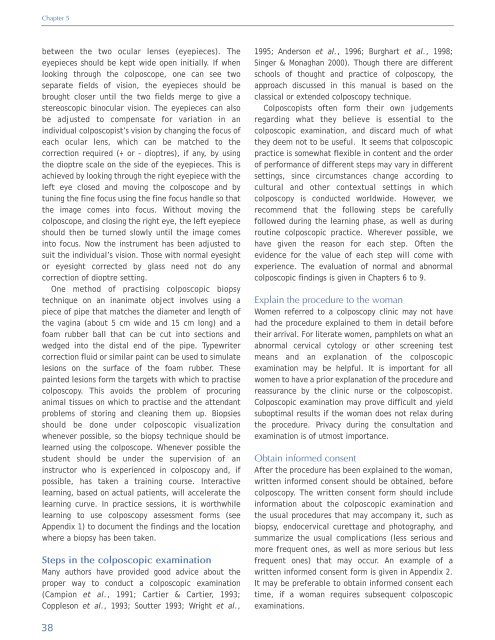Colposcopy and Treatment of Cervical Intraepithelial Neoplasia - RHO
Colposcopy and Treatment of Cervical Intraepithelial Neoplasia - RHO
Colposcopy and Treatment of Cervical Intraepithelial Neoplasia - RHO
You also want an ePaper? Increase the reach of your titles
YUMPU automatically turns print PDFs into web optimized ePapers that Google loves.
Chapter 5<br />
between the two ocular lenses (eyepieces). The<br />
eyepieces should be kept wide open initially. If when<br />
looking through the colposcope, one can see two<br />
separate fields <strong>of</strong> vision, the eyepieces should be<br />
brought closer until the two fields merge to give a<br />
stereoscopic binocular vision. The eyepieces can also<br />
be adjusted to compensate for variation in an<br />
individual colposcopist’s vision by changing the focus <strong>of</strong><br />
each ocular lens, which can be matched to the<br />
correction required (+ or - dioptres), if any, by using<br />
the dioptre scale on the side <strong>of</strong> the eyepieces. This is<br />
achieved by looking through the right eyepiece with the<br />
left eye closed <strong>and</strong> moving the colposcope <strong>and</strong> by<br />
tuning the fine focus using the fine focus h<strong>and</strong>le so that<br />
the image comes into focus. Without moving the<br />
colposcope, <strong>and</strong> closing the right eye, the left eyepiece<br />
should then be turned slowly until the image comes<br />
into focus. Now the instrument has been adjusted to<br />
suit the individual’s vision. Those with normal eyesight<br />
or eyesight corrected by glass need not do any<br />
correction <strong>of</strong> dioptre setting.<br />
One method <strong>of</strong> practising colposcopic biopsy<br />
technique on an inanimate object involves using a<br />
piece <strong>of</strong> pipe that matches the diameter <strong>and</strong> length <strong>of</strong><br />
the vagina (about 5 cm wide <strong>and</strong> 15 cm long) <strong>and</strong> a<br />
foam rubber ball that can be cut into sections <strong>and</strong><br />
wedged into the distal end <strong>of</strong> the pipe. Typewriter<br />
correction fluid or similar paint can be used to simulate<br />
lesions on the surface <strong>of</strong> the foam rubber. These<br />
painted lesions form the targets with which to practise<br />
colposcopy. This avoids the problem <strong>of</strong> procuring<br />
animal tissues on which to practise <strong>and</strong> the attendant<br />
problems <strong>of</strong> storing <strong>and</strong> cleaning them up. Biopsies<br />
should be done under colposcopic visualization<br />
whenever possible, so the biopsy technique should be<br />
learned using the colposcope. Whenever possible the<br />
student should be under the supervision <strong>of</strong> an<br />
instructor who is experienced in colposcopy <strong>and</strong>, if<br />
possible, has taken a training course. Interactive<br />
learning, based on actual patients, will accelerate the<br />
learning curve. In practice sessions, it is worthwhile<br />
learning to use colposcopy assessment forms (see<br />
Appendix 1) to document the findings <strong>and</strong> the location<br />
where a biopsy has been taken.<br />
Steps in the colposcopic examination<br />
Many authors have provided good advice about the<br />
proper way to conduct a colposcopic examination<br />
(Campion et al., 1991; Cartier & Cartier, 1993;<br />
Coppleson et al., 1993; Soutter 1993; Wright et al.,<br />
1995; Anderson et al., 1996; Burghart et al., 1998;<br />
Singer & Monaghan 2000). Though there are different<br />
schools <strong>of</strong> thought <strong>and</strong> practice <strong>of</strong> colposcopy, the<br />
approach discussed in this manual is based on the<br />
classical or extended colposcopy technique.<br />
Colposcopists <strong>of</strong>ten form their own judgements<br />
regarding what they believe is essential to the<br />
colposcopic examination, <strong>and</strong> discard much <strong>of</strong> what<br />
they deem not to be useful. It seems that colposcopic<br />
practice is somewhat flexible in content <strong>and</strong> the order<br />
<strong>of</strong> performance <strong>of</strong> different steps may vary in different<br />
settings, since circumstances change according to<br />
cultural <strong>and</strong> other contextual settings in which<br />
colposcopy is conducted worldwide. However, we<br />
recommend that the following steps be carefully<br />
followed during the learning phase, as well as during<br />
routine colposcopic practice. Wherever possible, we<br />
have given the reason for each step. Often the<br />
evidence for the value <strong>of</strong> each step will come with<br />
experience. The evaluation <strong>of</strong> normal <strong>and</strong> abnormal<br />
colposcopic findings is given in Chapters 6 to 9.<br />
Explain the procedure to the woman<br />
Women referred to a colposcopy clinic may not have<br />
had the procedure explained to them in detail before<br />
their arrival. For literate women, pamphlets on what an<br />
abnormal cervical cytology or other screening test<br />
means <strong>and</strong> an explanation <strong>of</strong> the colposcopic<br />
examination may be helpful. It is important for all<br />
women to have a prior explanation <strong>of</strong> the procedure <strong>and</strong><br />
reassurance by the clinic nurse or the colposcopist.<br />
Colposcopic examination may prove difficult <strong>and</strong> yield<br />
suboptimal results if the woman does not relax during<br />
the procedure. Privacy during the consultation <strong>and</strong><br />
examination is <strong>of</strong> utmost importance.<br />
Obtain informed consent<br />
After the procedure has been explained to the woman,<br />
written informed consent should be obtained, before<br />
colposcopy. The written consent form should include<br />
information about the colposcopic examination <strong>and</strong><br />
the usual procedures that may accompany it, such as<br />
biopsy, endocervical curettage <strong>and</strong> photography, <strong>and</strong><br />
summarize the usual complications (less serious <strong>and</strong><br />
more frequent ones, as well as more serious but less<br />
frequent ones) that may occur. An example <strong>of</strong> a<br />
written informed consent form is given in Appendix 2.<br />
It may be preferable to obtain informed consent each<br />
time, if a woman requires subsequent colposcopic<br />
examinations.<br />
38
















